fuel consumption YAMAHA TMAX 2015 Owners Manual
[x] Cancel search | Manufacturer: YAMAHA, Model Year: 2015, Model line: TMAX, Model: YAMAHA TMAX 2015Pages: 112, PDF Size: 6.38 MB
Page 8 of 112

TABLE OF CONTENTSSAFETY INFORMATION................... 1-1
Further safe-riding points................. 1-5
DESCRIPTION ................................... 2-1
Left view .......................................... 2-1
Right view ........................................ 2-2
Controls and instrument s................. 2-3
SMART KEY SYSTEM ....................... 3-1
Smart key system ......... ................... 3-1
Operating range of the smart key
system ....................... ................... 3-2
Handling of the smart key and mechanical key ............................ 3-3
Smart key ........................................ 3-5
Replacing the smart key battery ...... 3-6
Vehicle power on and steering lock release .................................. 3-7
Powering off th e vehicle .................. 3-8
How to lock the steering .................. 3-9
Seat opening and closin g ................ 3-9
Parking mode ................................ 3-10
INSTRUMENT AND CONTROL
FUNCTIONS ....................................... 4-1
Indicator lights and warning lights ... 4-1
Speedometer ................................... 4-2
Tachometer ..................................... 4-3
Multi-function display ....................... 4-3
Handlebar switches ......................... 4-9
Front brake lever ........................... 4-11 Rear brake lever............................ 4-11
Rear brake lock lever .................... 4-12
ABS (for ABS models)...
................ 4-13
Fuel tank cap................................. 4-14
Fuel ............................................... 4-15
Catalytic converter ........................ 4-16
Adjusting the rider backrest........... 4-17
Helmet holder ................................ 4-17
Storage compartments .................. 4-18
Windshield..................................... 4-20
Rear view mirrors .......................... 4-21
Shock absorber assembly ............. 4-22
Sidestand ...................................... 4-22
Ignition circuit cut- off system ......... 4-23
Auxiliary DC connector.................. 4-25
FOR YOUR SAFETY –
PRE-OPERATION CHECKS ............. 5-1
OPERATION AND IMPORTANT
RIDING POINTS ................................. 6-1
Starting the engine .......................... 6-1
Starting off ....................................... 6-2
Acceleration and deceleration ......... 6-3
Braking ............................................ 6-3
Tips for reducing fuel consumption ................................ 6-4
Engine break-in ............................... 6-4
Parking ............................................ 6-5 PERIODIC MAINTENANCE AND
ADJUSTMENT
.................................... 7-1
Owner’s tool kit ................................ 7-2
Periodic maintenance chart for the emission control syst em ............... 7-3
General maintenance and lubrication chart ............................ 7-4
Removing and installing panels ....... 7-8
Checking the spark plugs .............. 7-10
Engine oil and oil filt er cartridge..... 7-11
Coolant .......................................... 7-14
Replacing the air filter element ...... 7-16
Adjusting the engine idling speed............ ............................ .. 7-16
Checking the throttle grip free play ............................................. 7-17
Valve clearance ............................. 7-17
Tires ............................................... 7-18
Cast wheels ................................... 7-20
Checking the front and rear brake
lever free play ............................. 7-20
Adjusting the rear brake lock cable ........................................... 7-21
Checking the rear brake lock ......... 7-22
Checking the front and rear brake pads............................................ 7-22
Checking the brake fluid level ........ 7-23
Changing the brake fluid ................ 7-24
Drive belt slack .............................. 7-24
Checking and lubricating the
cables
......................................... 7-25
2PW-9-E0_1.book 1 ページ 2015年2月19日 木曜日 午後3時30分
Page 30 of 112
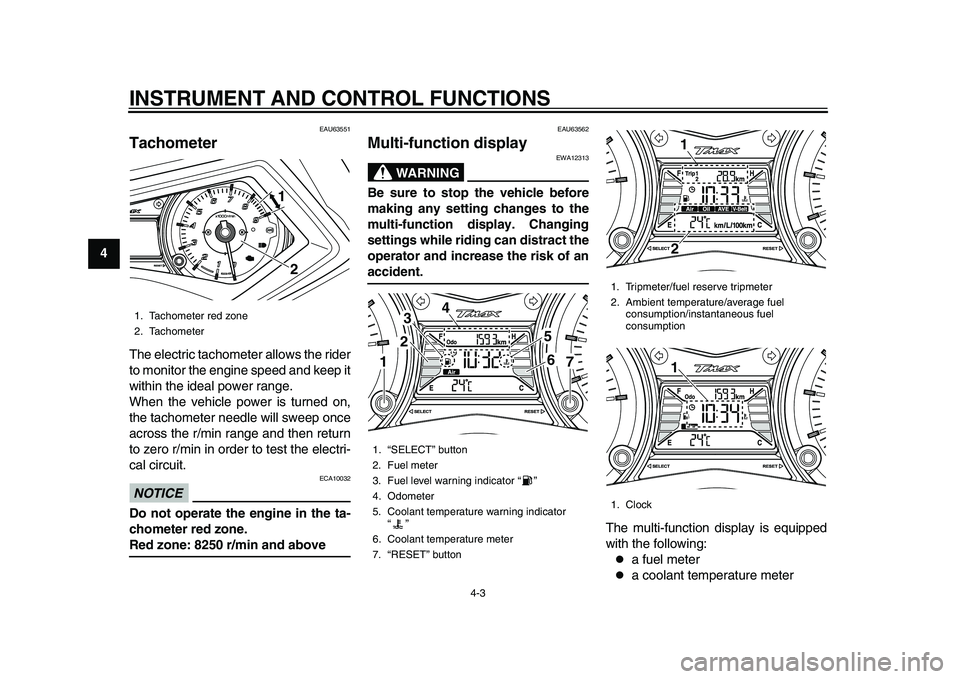
INSTRUMENT AND CONTROL FUNCTIONS
4-3
1
2
34
5
6
7
8
9
10
11
12
EAU63551
TachometerThe electric tachometer allows the rider
to monitor the engine speed and keep it
within the ideal power range.
When the vehicle power is turned on,
the tachometer needle will sweep once
across the r/min range and then return
to zero r/min in order to test the electri-
cal circuit.NOTICE
ECA10032
Do not operate the engine in the ta-
chometer red zone.Red zone: 8250 r/min and above
EAU63562
Multi-function display
WARNING
EWA12313
Be sure to stop the vehicle before
making any setting changes to the
multi-function display. Changing
settings while riding can distract the
operator and increase the risk of anaccident.
The multi-function display is equipped
with the following:
a fuel meter
a coolant temperature meter
1. Tachometer red zone
2. Tachometer
21
1. “SELECT” button
2. Fuel meter
3. Fuel level warning indicator “ ”
4. Odometer
5. Coolant temperature warning indicator “”
6. Coolant temperature meter
7. “RESET” button
23
4
56
11
7
1. Tripmeter/fuel reserve tripmeter
2. Ambient temperature/average fuel consumption/instantaneous fuel
consumption
1. Clock
211
2PW-9-E0_1.book 3 ページ 2015年2月19日 木曜日 午後3時30分
Page 31 of 112
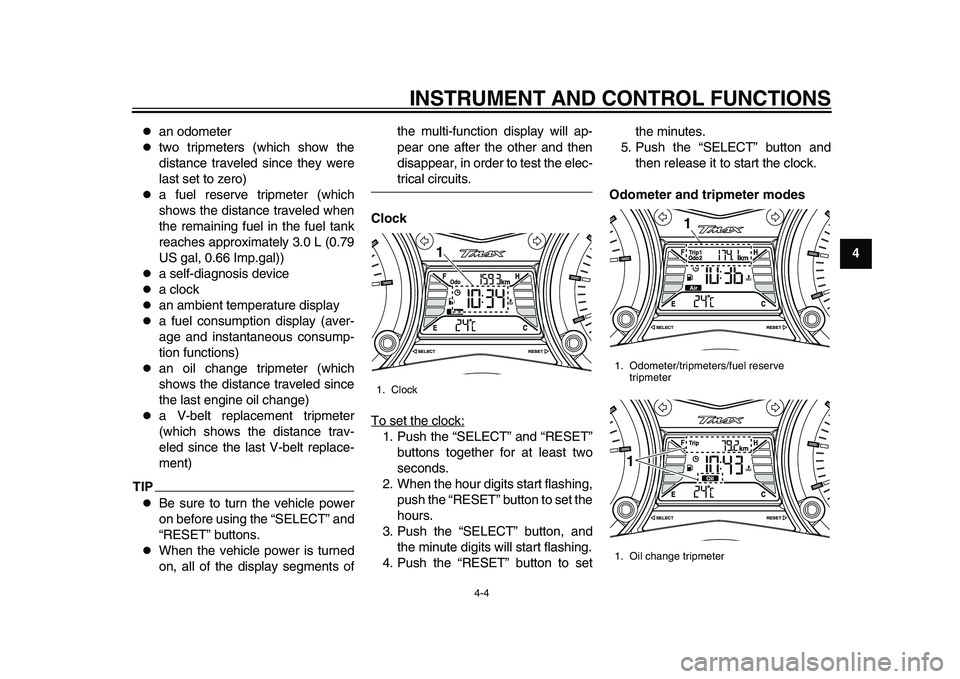
INSTRUMENT AND CONTROL FUNCTIONS
4-4
1
2
345
6
7
8
9
10
11
12
an odometer
two tripmeters (which show the
distance traveled since they were
last set to zero)
a fuel reserve tripmeter (which
shows the distance traveled when
the remaining fuel in the fuel tank
reaches approximately 3.0 L (0.79
US gal, 0.66 Imp.gal))
a self-diagnosis device
a clock
an ambient temperature display
a fuel consumption display (aver-
age and instantaneous consump-
tion functions)
an oil change tripmeter (which
shows the distance traveled since
the last engine oil change)
a V-belt replacement tripmeter
(which shows the distance trav-
eled since the last V-belt replace-
ment)
TIP
Be sure to turn the vehicle power
on before using the “SELECT” and
“RESET” buttons.
When the vehicle power is turned
on, all of the display segments of the multi-function display will ap-
pear one after the other and then
disappear, in order to test the elec-
trical circuits.
Clock
To set the clock:
1. Push the “SELECT” and “RESET” buttons together for at least two
seconds.
2. When the hour digits start flashing, push the “RESET” button to set the
hours.
3. Push the “SELECT” button, and the minute digits will start flashing.
4. Push the “RESET” button to set the minutes.
5. Push the “SELECT” button and then release it to start the clock.
Odometer and tripmeter modes1. Clock
1
1. Odometer/tripmeters/fuel reserve tripmeter
1. Oil change tripmeter
1
1
2PW-9-E0_1.book 4 ページ 2015年2月19日 木曜日 午後3時30分
Page 34 of 112

INSTRUMENT AND CONTROL FUNCTIONS
4-7
1
2
34
5
6
7
8
9
10
11
12 second. When pushing the “SELECT”
button, “V-Belt Trip” starts flashing.
While “V-Belt Trip” is flashing, push the
“SELECT” button for at least three sec-
onds.
If the V-belt is changed before the
V-belt replacement indicator “V-Belt”
flashes (i.e. before the periodic V-belt
change interval has been reached), the
indicator “V-Belt” must be reset after
the V-belt change for the next periodic
V-belt change to be indicated at the
correct time.
The electrical circuit of the indicator can
be checked according to the following
procedure.
1. Turn the vehicle on and make sure that the engine stop switch is set to
“”.
2. Check that the V-belt replacement indicator comes on for a few sec-
onds and then goes off.
3. If the V-belt replacement indicator does not come on, have a Yamaha
dealer check the el ectrical circuit.Ambient temperature display, aver-
age fuel consumption, and instan-
taneous fuel consumption modes
Push the “RESET” button to switch the
display between the ambient tempera-
ture display “Air”, the average fuel con-
sumption mode “AVE_ _._ km/L” or
“AVE_ _._ L/100 km”, and the instanta-
neous fuel consumption mode “km/L”
or “L/100 km” in the following order:
Air
AVE_ _._ km/L or AVE_ _._ L/
100 km km/L or L/100 km Air
For the UK only:
Push the “RESET” button to switch the display between the ambient tempera-
ture display “Air”, the average fuel con-
sumption mode “AVE_ _._ MPG” and
the instantaneous fuel consumption
mode “MPG” in the following order:
Air
AVE_ _._ MPG MPG Air
Ambient temperature display
This display shows the ambient tem-
perature from –9 C to 40 C in 1 C in-
crements.
For the UK only:
15 F to 104 F in 1 F increments.
The temperature displayed may vary
from the ambient temperature. Pushing
1. Ambient temperature/average fuel consumption/instantaneous fuel
consumption
1
1. Ambient temperature display1
2PW-9-E0_1.book 7 ページ 2015年2月19日 木曜日 午後3時30分
Page 35 of 112
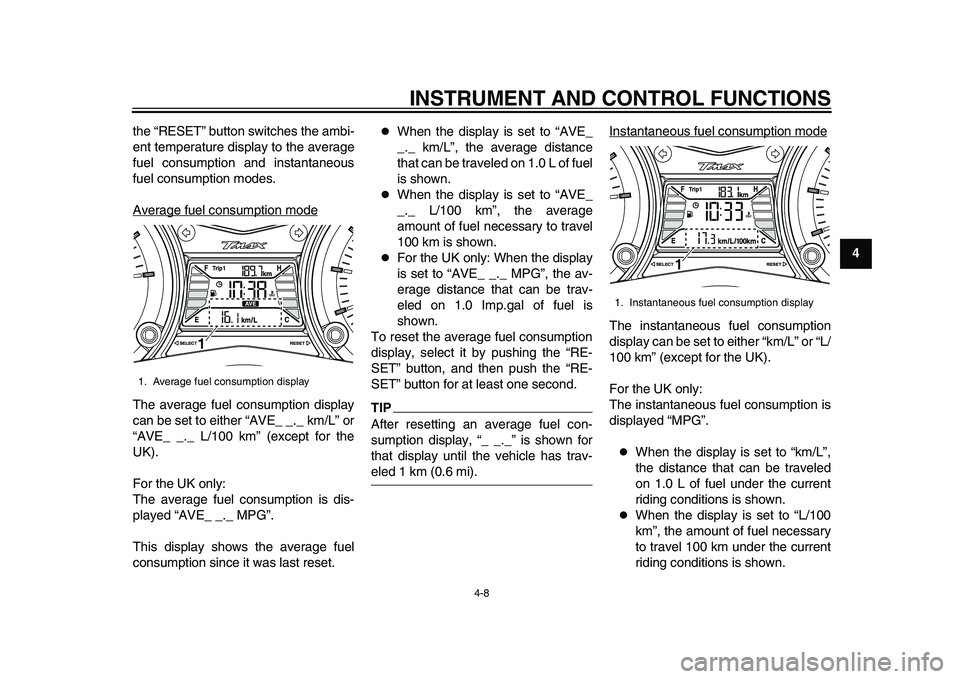
INSTRUMENT AND CONTROL FUNCTIONS
4-8
1
2
345
6
7
8
9
10
11
12
the “RESET” button switches the ambi-
ent temperature display to the average
fuel consumption and instantaneous
fuel consumption modes.
Average fuel consumption mode
The average fuel consumption display
can be set to either “AVE_ _._ km/L” or
“AVE_ _._ L/100 km” (except for the
UK).
For the UK only:
The average fuel consumption is dis-
played “AVE_ _._ MPG”.
This display shows the average fuel
consumption since it was last reset.
When the display is set to “AVE_
_._ km/L”, the average distance
that can be traveled on 1.0 L of fuel
is shown.
When the display is set to “AVE_
_._ L/100 km”, the average
amount of fuel necessary to travel
100 km is shown.
For the UK only: When the display
is set to “AVE_ _._ MPG”, the av-
erage distance that can be trav-
eled on 1.0 Imp.gal of fuel is
shown.
To reset the average fuel consumption
display, select it by pushing the “RE-
SET” button, and then push the “RE-
SET” button for at least one second.
TIPAfter resetting an average fuel con-
sumption display, “_ _._” is shown for
that display until the vehicle has trav-eled 1 km (0.6 mi). Instantaneous fuel consumption mode
The instantaneous fuel consumption
display can be set to either “km/L” or “L/
100 km” (except for the UK).
For the UK only:
The instantaneous fuel consumption is
displayed “MPG”.
When the display is set to “km/L”,
the distance that can be traveled
on 1.0 L of fuel under the current
riding conditions is shown.
When the display is set to “L/100
km”, the amount of fuel necessary
to travel 100 km under the current
riding conditions is shown.
1. Average fuel consumption display
1
1. Instantaneous fuel consumption display
1
2PW-9-E0_1.book 8 ページ 2015年2月19日 木曜日 午後3時30分
Page 36 of 112
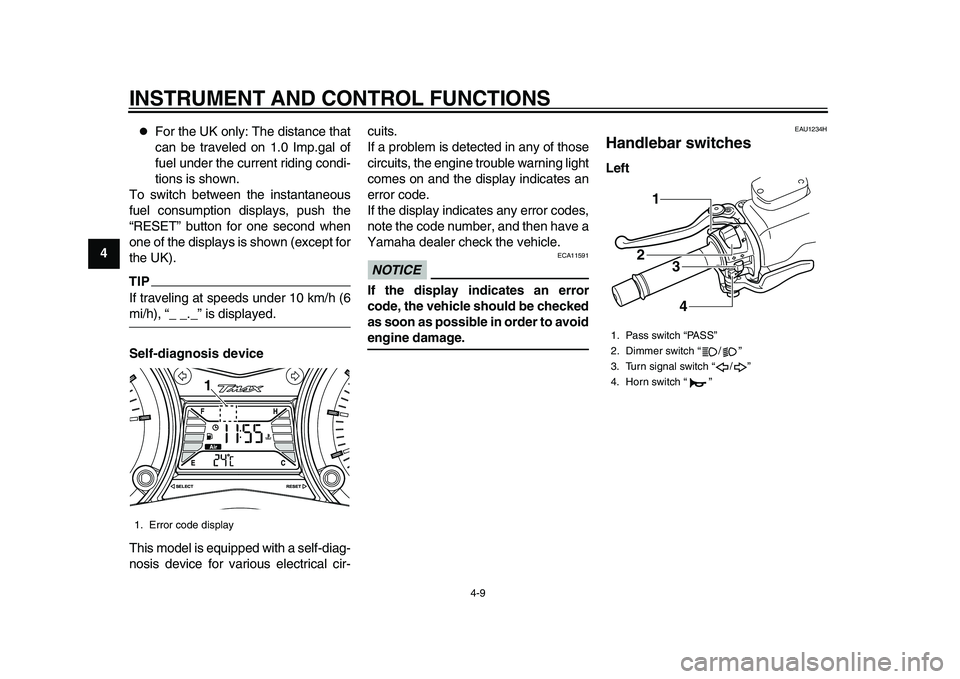
INSTRUMENT AND CONTROL FUNCTIONS
4-9
1
2
34
5
6
7
8
9
10
11
12
For the UK only: The distance that
can be traveled on 1.0 Imp.gal of
fuel under the current riding condi-
tions is shown.
To switch between the instantaneous
fuel consumption displays, push the
“RESET” button for one second when
one of the displays is shown (except for
the UK).
TIPIf traveling at speeds under 10 km/h (6mi/h), “_ _._” is displayed.
Self-diagnosis device
This model is equipped with a self-diag-
nosis device for various electrical cir- cuits.
If a problem is detected in any of those
circuits, the engine
trouble warning light
comes on and the display indicates an
error code.
If the display indicates any error codes,
note the code number, and then have a
Yamaha dealer check the vehicle.
NOTICE
ECA11591
If the display indicates an error
code, the vehicle should be checked
as soon as possible in order to avoidengine damage.
EAU1234H
Handlebar switchesLeft
1. Error code display
1
1. Pass switch “PASS”
2. Dimmer switch “ / ”
3. Turn signal switch “ / ”
4. Horn switch “ ”
1
2
3
4
2PW-9-E0_1.book 9 ページ 2015年2月19日 木曜日 午後3時30分
Page 58 of 112
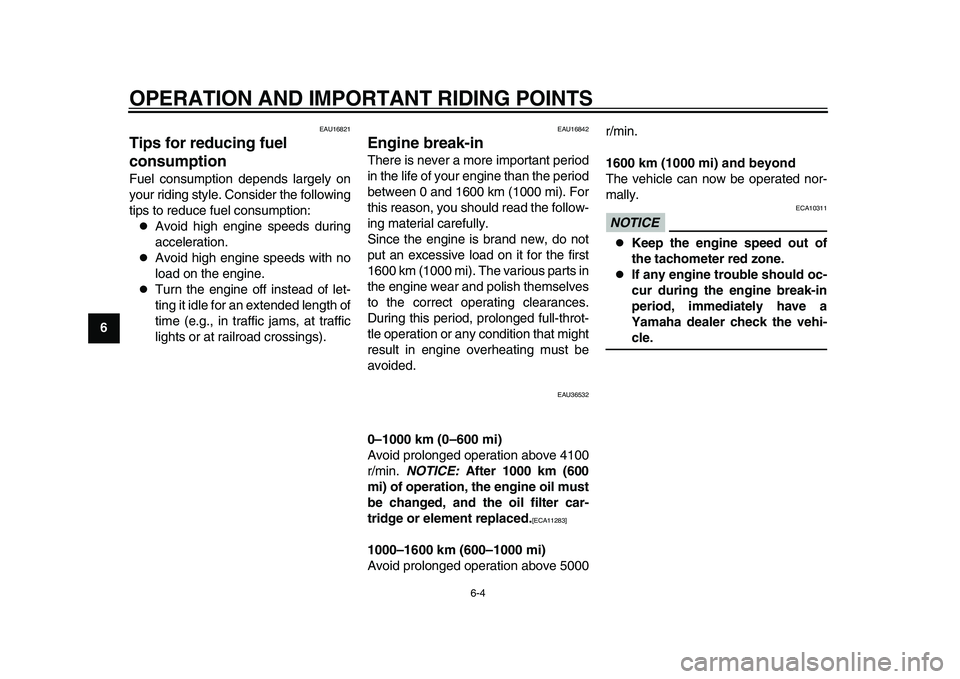
OPERATION AND IMPORTANT RIDING POINTS
6-4
1
2
3
4
56
7
8
9
10
11
12
EAU16821
Tips for reducing fuel
consumptionFuel consumption depends largely on
your riding style. Consider the following
tips to reduce fuel consumption:
Avoid high engine speeds during
acceleration.
Avoid high engine speeds with no
load on the engine.
Turn the engine off instead of let-
ting it idle for an extended length of
time (e.g., in traffic jams, at traffic
lights or at railroad crossings).
EAU16842
Engine break-inThere is never a more important period
in the life of your engine than the period
between 0 and 1600 km (1000 mi). For
this reason, you should read the follow-
ing material carefully.
Since the engine is brand new, do not
put an excessive load on it for the first
1600 km (1000 mi). The various parts in
the engine wear and polish themselves
to the correct operating clearances.
During this period, prolonged full-throt-
tle operation or any condition that might
result in engine overheating must be
avoided.
EAU36532
0–1000 km (0–600 mi)
Avoid prolonged operation above 4100
r/min. NOTICE: After 1000 km (600
mi) of operation, the engine oil must
be changed, and the oil filter car-
tridge or element replaced.
[ECA11283]
1000–1600 km (600–1000 mi)
Avoid prolonged operation above 5000 r/min.
1600 km (1000 mi) and beyond
The vehicle can now be operated nor-
mally.
NOTICE
ECA10311
Keep the engine speed out of
the tachometer red zone.
If any engine trouble should oc-
cur during the engine break-in
period, immediately have a
Yamaha dealer check the vehi-cle.
2PW-9-E0_1.book 4 ページ 2015年2月19日 木曜日 午後3時30分
Page 108 of 112
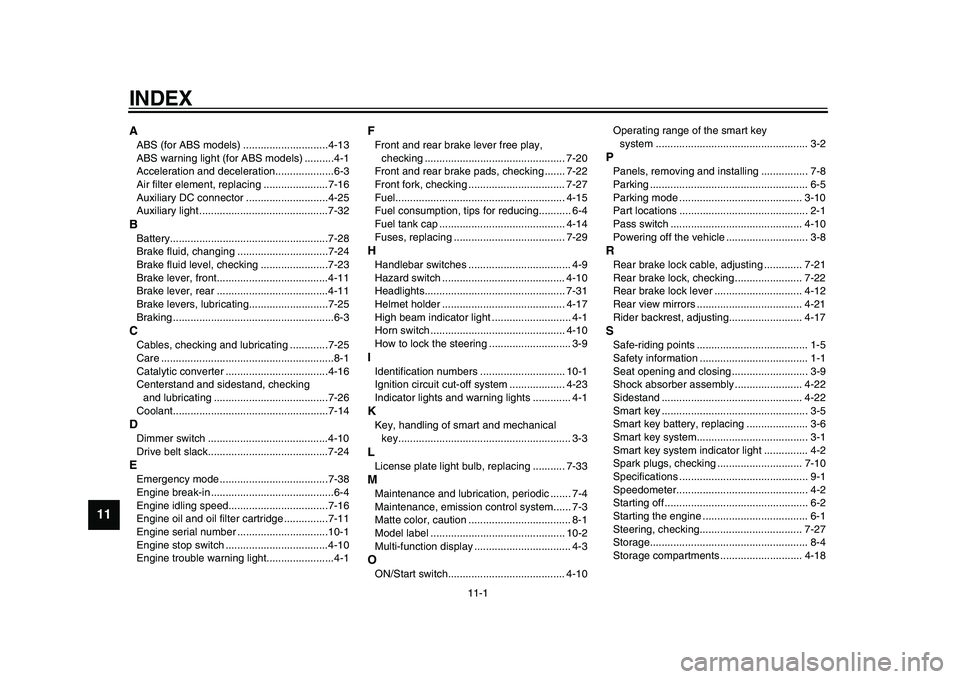
11-1
1
2
3
4
5
6
7
8
9
1011
12
INDEXAABS (for ABS models) .............................4-13
ABS warning light (for ABS models) ..........4-1
Acceleration and deceleration....................6-3
Air filter element, replacing ......................7-16
Auxiliary DC connector ............................4-25
Auxiliary light ............................................7-32BBattery......................................................7-28
Brake fluid, changing ...............................7-24
Brake fluid level, checking .......................7-23
Brake lever, front......................................4-11
Brake lever, rear ......................................4-11
Brake levers, lubricating...........................7-25
Braking .......................................................6-3CCables, checking and lubricating .............7-25
Care ...........................................................8-1
Catalytic converter ...................................4-16
Centerstand and sidestand, checking and lubricating .......................................7-26
Coolant.....................................................7-14DDimmer switch .........................................4-10
Drive belt slack.........................................7-24EEmergency mode .....................................7-38
Engine break-in ..........................................6-4
Engine idling speed..................................7-16
Engine oil and oil filter cartridge ...............7-11
Engine serial number ...............................10-1
Engine stop switch ...................................4-10
Engine trouble warning light.......................4-1
FFront and rear brak e lever free play,
checking ................................................ 7-20
Front and rear brake pads, checking ....... 7-22
Front fork, checking ................................. 7-27
Fuel.......................................................... 4-15
Fuel consumption, tips for reducing........... 6-4
Fuel tank cap ........................................... 4-14
Fuses, replacing ...................................... 7-29HHandlebar switches ................................... 4-9
Hazard switch .......................................... 4-10
Headlights................................................ 7-31
Helmet holder .......................................... 4-17
High beam indicator light ........................... 4-1
Horn switch .............................................. 4-10
How to lock the steering ............................ 3-9IIdentification numbers ............................. 10-1
Ignition circuit cut-off system ................... 4-23
Indicator lights and warning lights ............. 4-1KKey, handling of smart and mechanical
key........................................................... 3-3LLicense plate light bulb, replacing ........... 7-33MMaintenance and lubrication, periodic ....... 7-4
Maintenance, emission control system...... 7-3
Matte color, caution ................................... 8-1
Model label .............................................. 10-2
Multi-function display ................................. 4-3OON/Start switch........................................ 4-10 Operating range of the smart key
system .................................................... 3-2
PPanels, removing and installing ................ 7-8
Parking ...................................................... 6-5
Parking mode .......................................... 3-10
Part locations ............................................ 2-1
Pass switch ............................................. 4-10
Powering off the vehicle ............................ 3-8RRear brake lock cable, adjusting ............. 7-21
Rear brake lock, checking ....................... 7-22
Rear brake lock lever .............................. 4-12
Rear view mirrors .................................... 4-21
Rider backrest, adjusting......................... 4-17SSafe-riding points ...................................... 1-5
Safety information ..................................... 1-1
Seat opening and closing .......................... 3-9
Shock absorber assembly ....................... 4-22
Sidestand ................................................ 4-22
Smart key .................................................. 3-5
Smart key battery, replacing ..................... 3-6
Smart key system...................................... 3-1
Smart key system indicator light ............... 4-2
Spark plugs, checking ............................. 7-10
Specifications ............................................ 9-1
Speedometer............................................. 4-2
Starting off ................................................. 6-2
Starting the engine .................................... 6-1
Steering, checking................................... 7-27
Storage...................................................... 8-4
Storage compartments ............................ 4-18
2PW-9-E0_1.book 1 ページ 2015年2月19日 木曜日 午後3時30分